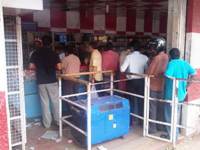|
Day to day life in Kochi
Kochi represents India in transition. Much of the day to day bustle and traffic, the chain stores and restaurants are not dissimilar from a western city. However, not far under the surface, many patterns of life continue to follow older traditions.
Traffic
.....is chaotic! Not so much in its volume – rush hours do not approach UK levels of congestion – but in its make-up and levels of (in)discipline.
It is said that Indian society can be split into three classes – owning cars, motor bikes or bullock carts respectively. There are no bullock carts in Kochi but these are substituted by a large number of buses of every type and condition, usually full to bursting point and going at breakneck speed. These are fine for the local population but, for the visitor, the very limited destination information, usually only shown in local Malayalam script, makes them unusable (unlike the long distance buses which are very useful). Swirling around the buses are a “sea” of motor bikes and autos (three wheelers acting as taxis or goods trucks). Disciplines for the two and three-wheelers are non-existent – the shortest route between two points is normally taken, whether on the correct side of the road or not and independent of any traffic controls. The minor players in numbers are the cars – mostly small local variants of Japanese or European models made under licence. There are very few large cars.
As a pedestrian, the traffic presents interesting challenges! There are few good pavements which means that walking in the road is normal. Crossing the road is a nightmare – pedestrian crossings are ignored – and it just requires blind faith that your judgement of vehicle speeds, directions and intentions are roughly accurate. If you get it wrong, there is no great upset because such aberrant behaviour is “normal” but to be surrounded by vehicles going in front, behind and around you, all blaring their horns, can be a little disconcerting!
Shopping
Kochi is still in the craft shop mode. Most shops only sell a narrow range of merchandise, and similar types of shop tend to group together. So you will find a street full of furniture shops or hardware shops or builders merchants, indistinguishable to the visitor but all apparently prospering. This makes shopping somewhat complicated – what in the UK would require one visit to a large Tesco, in Kochi requires a treck round the whole city to track down the four or five different shops required.
Buying food
Again, Kochi hovers between the old and the new. The old is represented by the market – dozens of stalls selling vegetables or fruit or fish. Again, each stall has its speciality and buying daily requirements requires visits to at least three stalls. English is not widespread among stall holders so much pointing and debate in pidgin English is required to get what you want. Meat is not widely sold –many Indians are vegetarian and there are religious restrictions on beef and pork.
The new is represented by supermarkets – but only a few small ones, think of Tesco Express. These stock the coffee, tea, dairy produce, pulses and grains of every description and cleaning products. Not very exciting and stock management is terrible – so you have no confidence on any given visit that you will be able to find what you bought there last time! Again a “round Kochi tour” is often required!
Bread is a particular problem. Indian style breads (naan, chappathi etc) are made at home and the only bread on sale is normally white sliced, with added sugar – really very unpleasant! We have found a way out by buying bread at a deli in one of the better hotels, where they bake European style breads for their restaurant.
Restaurants
Generally nothing like an Indian restaurant in the UK! Typically, a range of vegetarian dishes with various style of sauce plus dry dishes like Tandoori chicken. Not very hot in the spicy sense but a wide range of spice flavours. Typically two or three dishes will be ordered and eaten with bread or rice – with the right hand only, which is messy until practised!
Snacks are widely available, things like samosas or bajiis, either on the street or in restaurants, but these tend to be eaten between meals not as part of meals.
Alcohol
India has, officially, a strong disapproval of alcohol. Though only Muslims and some other religious sects are actually banned from drinking there is a general attitude that drink is the road to perdition and there is no encouragement of social drinking. Bars where they exist are fairly low dives.
Alcohol is not generally available in restaurants (except sometimes beer) and is not sold in food shops or supermarkets. The government monopoly controls sales through its own dedicated outlets and creates the problem it is most concerned about by selling basic rum and brandy at knock down (or fall down!) prices, around £5 a bottle, while pricing wine (even local wine) out of the market at around £8-10 a bottle. Only beer is roughly normally priced at £1 a bottle, though this is expensive for the local populace. The result is predictable – the cheap brandy and rum is used to create instant oblivion and Indians tend to “drink to get drunk”. Most middle class families have servants, so the “queue of shame” at the controlled outlets is composed of low class workers and servants, with the middle classes absent (except for Guy!).

Kerala is an extreme example though not as extreme as say Punjab which is totally dry. The big urban centres like Delhi or Mumbai or Bangalore have more civilised bars and more available alcohol, though still not at European level
GC
| 